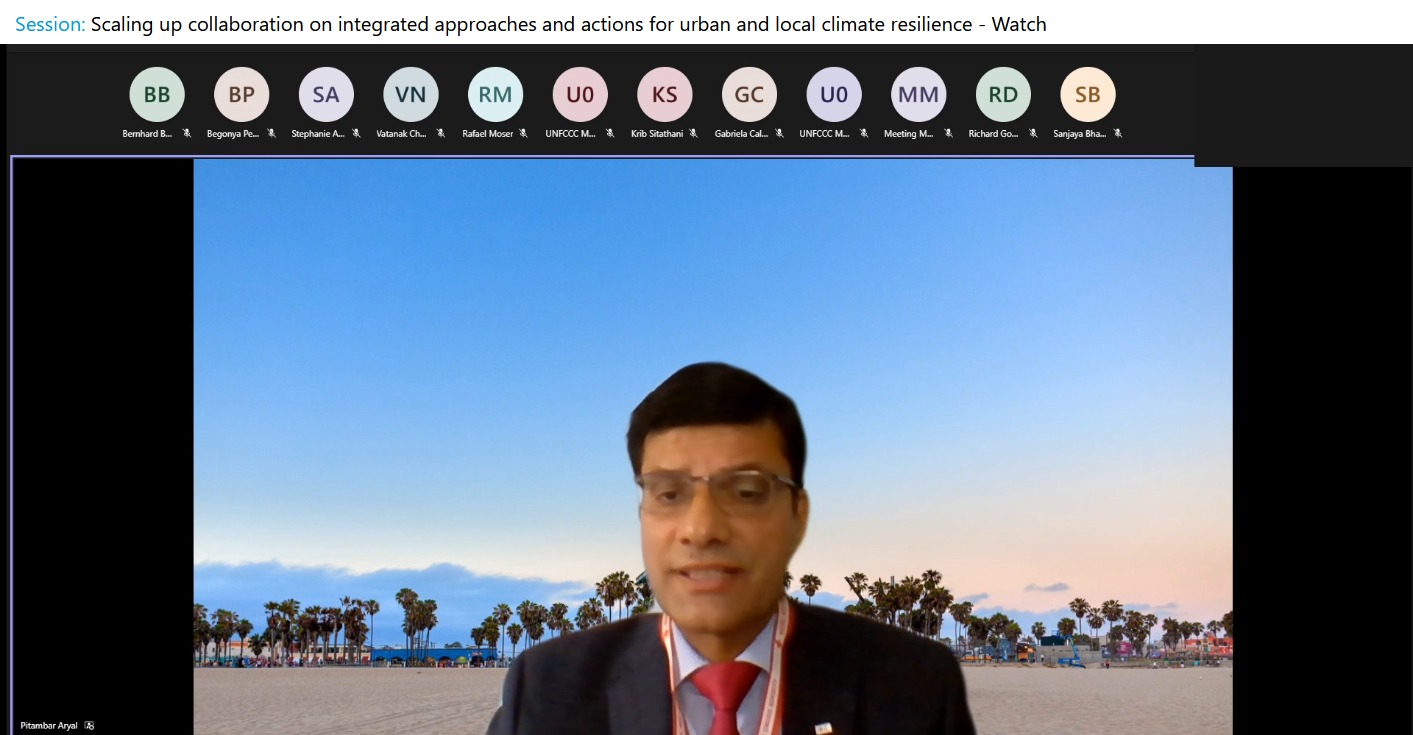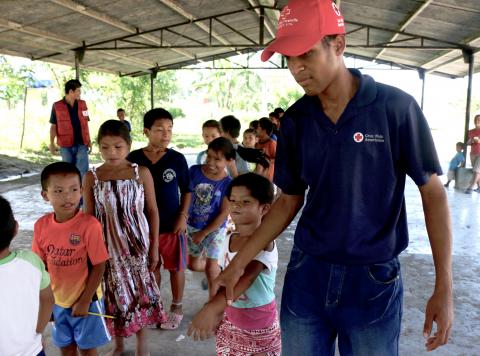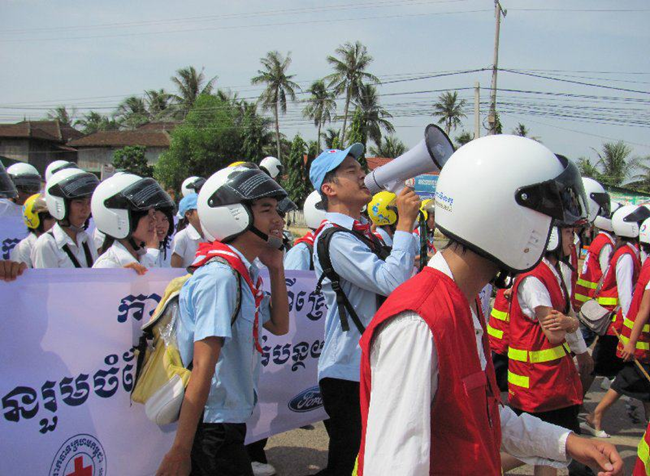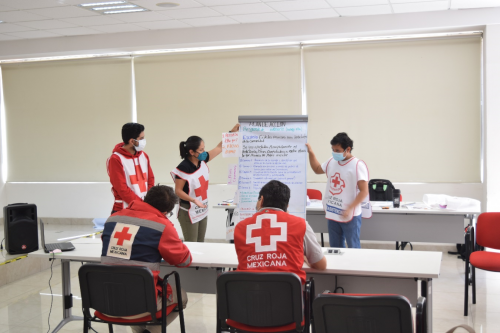Highlights from UNFCCC Asia Pacific Climate Week: Nepal Red Cross Secretary General Aryal shares insights on how urban resilience programming shaped Nepal’s NAP

As auxiliaries to government and interlocuters to communities, National Societies are uniquely positioned to support governments National DRR, DRM and Adaptation frameworks and plans.
On July 7, 2021, Secretary General of Nepal Red Cross Society (NRCS), Pitambar Aryal outlined the manifold ways National Societies add value to Natation Adaptation Plans in the UNFCCC APCW session, “Scaling up collaboration on integrated approaches and actions for urban and local climate resilience”.
The session co-led by UNCDF and UN-Habitat and organized by IFRC APRO, CDP Cities, States and Regions, UCLG-ASPAC, demonstrated good practices and lessons learned on empowering collective action on behalf of communities, local partners, cities, and local governments for enhanced climate resilience and adaptation results. Highlights from Secretary General of Nepal Red Cross Q&A below:
Q: ”What’s the added value of Nepal Red Cross Society and other humanitarian agencies participating in the NAP and similar processes?”
“The role of a National Society as “auxiliary to the public authorities in the humanitarian field” is at the core of our identity. It is within our mandate to serve as interlocutors of government and communities. As National Societies, we have the unique ability – and mandate – to serve as the bridge between at-risk communities and policymakers.
Nepal, is at high risk of humanitarian crises and disaster, ranking 32nd out of 192 countries. The country is prone to multiple hazards, including landslides, flash flooding, earthquakes, and droughts, compounded by climate change. In addition, the country continues to rapidly urbanize, bringing with it both livelihood opportunities, as well as new humanitarian complexities in terms of targeting those most vulnerable and ensuring their voices are heard.
In 2016, NRCS with support from the British Red Cross, launched the Strengthening Urban Resilience Engagement (SURE) project to improve the urban disaster resilience of municipal governments, the Nepal Red Cross Society, and urban populations, including specific target groups. NRCS applied a multi-hazard and networked approach, creating enabling environments at the municipal level and vertically integrating these into national frameworks, strategies and plans, to ensure no one is left behind. At the core, the program applies a targeted approach to connect the poor, vulnerable and socially excluded and support them to become community champions trained in UDRR and disseminating urban DRR messages local communities and engaged in bottom-up advocacy processes and support local government DRR initiatives.
1. We connect voices of those most vulnerable embedding them in the NAP planning process:
From the start of the NAP process, the Government of Nepal committed to “leave no one behind”. The Nepal Red Cross helped to operationalize this commitment by championing the voices of those most vulnerable – the marginalized and disadvantaged communities, indigenous and traditional groups, with special consideration for youth, women and people with disabilities – ensuring they are heard and needs are integrated within local, provincial and national processes. We focus heavily on vertical integration and coherence – for example, connecting 551 vulnerable communities to Local Adaptation Plans of Action and NAPs planning.
2. We support government to collect, analyse and design risk-informed, climate smart strategies and plans:
National Societies support all levels of government to collect and analyse information on the impact of climate change, risk and vulnerability for the design of climate-smart, risk-informed frameworks, strategies and plans. Within the NAP process, the Nepal Red Cross served on the Working Group for Disaster Risk Reduction, working alongside communities, we channelled over 200 of the most at-risk communities’ Vulnerability Capacity Assessments into this process, to ensure risk-informed approach.
Secondly, we ensure harmonized approaches to understanding risk. Nepal Red Cross heavily engaged with central, provincial and local levels of government to develop and revise the nation-wide Vulnerability and Risk Assessment Framework in more inclusive ways. We have decades of experience developing and testing inclusive tools, especially in urban areas, these are tools now owned by the government of Nepal and taken as a reference by development partners and humanitarian agencies in order to carry out harmonized climate and risk informed work.
3.We empower communities, especially those most vulnerable to understand, and champion the NAPs/ DRR/DRM strategies and plans through vertically-integrated action:
National Societies play a vital role in ensuring that communities’ needs are embedded within their respective climate change adaptation frameworks. Communities are ultimately the first responders to climate change and disasters, and it is therefore critical NAPs are linked to Local Adaptation Plans of Action, as well as grassroots, community-based DRR and DRM efforts. In the year 2020 and onwards through several DRR programs in local communities, NRCS has trained more than 6382 volunteers in DRR and climate resilience, and these volunteers are linked with the local governments and local government is ensuring the participation at local level climate smart VCA process equally they are mobilizing to carry on local actions. 1040 trained urban champions are mobilized in local communities to carry on for DRR implementation and advocacy to authorise the process and equally they are participating in the NAP process.
In addition engagement in the NAP process has added immense value to us as Nepal Red Cross:
- The NAP process has helped clarify the role of NRCS to “strengthen community resilience to climate risk by supporting communities at risk to design and implement integrated community disaster risk management plans, and NRCS programs are more “climate-risk adaptive” by integrating risks into activities planned as part of routine DRR work, such as safe drinking water and sanitation and promoting alternative sources of energy.
- The NRCS has also been involved in climate work outside the area of disaster management, but above all the NAP process and the move toward ‘climate-smart’ community VCAs has helped the National Society to see community problems through the climate change lens and to position itself as a crucial partner with various government-level actors in the country. The Ministry of the Environment and Science assigned a role to the NRCS on disaster risk reduction (DRR) – one of nine thematic areas of government priority within the NAP.
- Today NRCS and other relevant stakeholders working in Nepal are heavily engaged in central level implementation of NAP and localization of resources and actions being a core member in all tiers of government including NAP”.
Q: How can we [the humanitarian, climate and development community] promote further coherence between NAP and DRR strategies through stakeholder engagement?
“Based on our experience in the NAPs and similar DRR/DRM frameworks:
- Build strong and coherent legal foundations, which provide the enabling environment for effective disaster and climate action downstream. Our ability to support as humanitarians is only as strong as our national legal and regulatory frameworks. A well-functioning disaster risk management (DRRM) system requires a strong legal basis at the domestic level to ensure clarity in responsibilities, prioritization of activities, assignment of resources and coordination – from local to national level. In the case of Nepal we are fortunate to have mechanisms in place like the Disaster Risk Reduction Management Act 2074 (2017), td Local Government Act. For the past four years, Red Cross has also been working closely with MOFAGA to develop a local risk governance assessment tool, which aims to support systematic and inclusive disaster and climate governance at the municipal level, and to ensure national commitments get implemented where they are needed most – locally.
- Localize global agendas: institutionalize integrated and inclusive planning and coordination processes. In the case of Nepal, we reactivated the platforms, such as the Community-Based Disaster Risk Management Platform to strengthen and connect between national and local governments and also promote dialogue sessions, action research and knowledge building and dissemination. The localization of global agendas must be grounded in local capacities, resources and contexts to achieve the Sendai Framework targets and SDGs. This means participation, not just consultation. Real empowerment of communities, their recognition of local capacities, fostering grassroots DRR processes and championing community-based CCA, DRR and DRM to carry out LAPAS and expressly link to NAPs through the application of the Municipal Local Risk Governance Tool to ensure the operalization of international and national commitments translate to local level climate and resilience action.
- Harmonize climate-risk management tools: The Vulnerability and Risk Assessment Framework, developed by the RCRC, is owned by the government and applied by all”.
Watch the full session UNFCCC Asia-Pacific Climate Week session here.
This work has been recognized and is being applied across the Red Cross Red Crescent Movement, in the “National Societies for National Adaptation Plans” NS4NAPs initiative, a regional Asia Pacific programme launched in 2021 that aims to support national and sub-national levels of their government for country-level humanitarian work and of engaging with planners and in policy making processes.



